Unit 6 Immigration Bound for the United States
- 格式:doc
- 大小:33.00 KB
- 文档页数:3

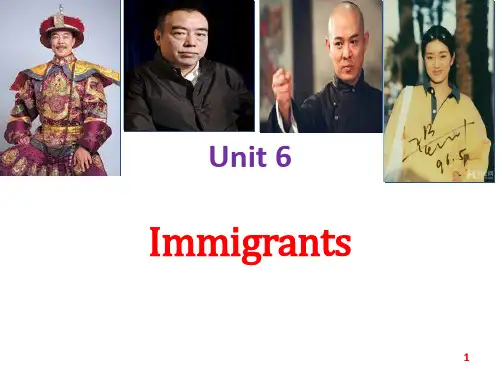
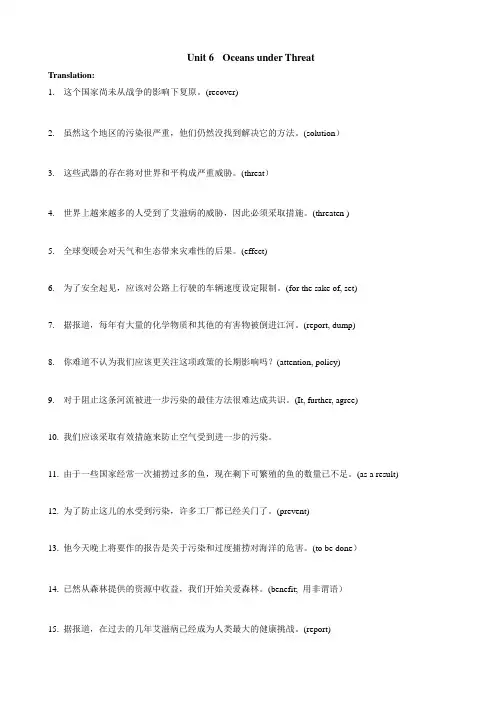
Translation:1.这个国家尚未从战争的影响下复原。
(recover)___________________________________________________________________________________________ 2.虽然这个地区的污染很严重,他们仍然没找到解决它的方法。
(solution)___________________________________________________________________________________________ 3.这些武器的存在将对世界和平构成严重威胁。
(threat)___________________________________________________________________________________________ 4.世界上越来越多的人受到了艾滋病的威胁,因此必须采取措施。
(threaten )___________________________________________________________________________________________ 5.全球变暖会对天气和生态带来灾难性的后果。
(effect)___________________________________________________________________________________________ 6.为了安全起见,应该对公路上行驶的车辆速度设定限制。
(for the sake of, set)___________________________________________________________________________________________ 7.据报道,每年有大量的化学物质和其他的有害物被倒进江河。
(report, dump)___________________________________________________________________________________________ 8.你难道不认为我们应该更关注这项政策的长期影响吗?(attention, policy)___________________________________________________________________________________________ 9.对于阻止这条河流被进一步污染的最佳方法很难达成共识。
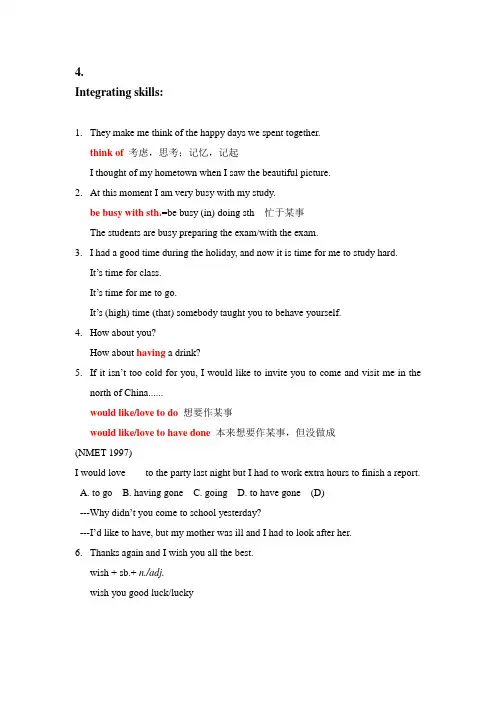
4.Integrating skills:1.They make me think of the happy days we spent together.think of考虑,思考;记忆,记起I thought of my hometown when I saw the beautiful picture.2.At this moment I am very busy with my study.be busy with sth.=be busy (in) doing sth 忙于某事The students are busy preparing the exam/with the exam.3.I had a good time during the holiday, and now it is time for me to study hard.It’s time for class.It’s time for me to go.It’s (high) time (that) somebody taught you to behave yourself.4.How about you?How about having a drink?5.If it isn’t too cold for you, I would like to invite you to come and visit me in thenorth of China......would like/love to do想要作某事would like/love to have done本来想要作某事,但没做成(NMET 1997)I would love ___ to the party last night but I had to work extra hours to finish a report.A. to goB. having goneC. goingD. to have gone (D)---Why didn’t you come to school yesterday?---I’d like to have, but my mother was ill and I had to look after her.6.Thanks again and I wish you all the best.wish + sb.+ n./adj.wish you good luck/lucky。
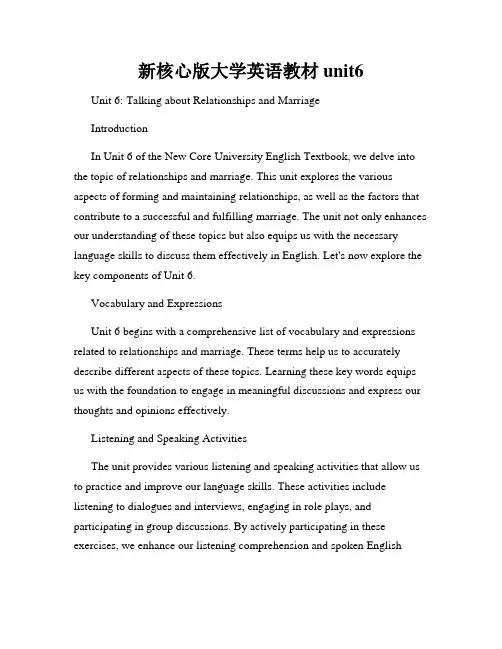
新核心版大学英语教材unit6Unit 6: Talking about Relationships and MarriageIntroductionIn Unit 6 of the New Core University English Textbook, we delve into the topic of relationships and marriage. This unit explores the various aspects of forming and maintaining relationships, as well as the factors that contribute to a successful and fulfilling marriage. The unit not only enhances our understanding of these topics but also equips us with the necessary language skills to discuss them effectively in English. Let's now explore the key components of Unit 6.Vocabulary and ExpressionsUnit 6 begins with a comprehensive list of vocabulary and expressions related to relationships and marriage. These terms help us to accurately describe different aspects of these topics. Learning these key words equips us with the foundation to engage in meaningful discussions and express our thoughts and opinions effectively.Listening and Speaking ActivitiesThe unit provides various listening and speaking activities that allow us to practice and improve our language skills. These activities include listening to dialogues and interviews, engaging in role plays, and participating in group discussions. By actively participating in these exercises, we enhance our listening comprehension and spoken Englishskills, enabling us to express ourselves fluently and confidently in real-life situations.Reading and ComprehensionThis unit introduces engaging reading passages that focus on different perspectives on relationships and marriage. By reading and comprehending these passages, we gain valuable insights into the challenges and rewards associated with these topics. Furthermore, we learn to analyze and interpret various arguments and opinions, which helps us develop critical thinking skills.Grammar and Language StructureUnit 6 also presents important grammar and language structures that are commonly used when discussing relationships and marriage. We learn how to form and use comparative and superlative adjectives to compare relationships, express preferences, and evaluate qualities. Additionally, we acquire a better understanding of the correct usage of prepositions, verbs, and adverbs when describing relationships and marital status.Writing TasksTo consolidate our learning, Unit 6 offers various writing tasks that focus on relationships and marriage. These tasks enable us to apply the language skills acquired throughout the unit and formulate coherent and cohesive written pieces. We learn how to express our personal opinions, argue for or against certain perspectives, and analyze the impact of societal norms on relationships and marriage.ConclusionIn conclusion, Unit 6 of the New Core University English Textbook provides a comprehensive exploration of relationships and marriage. Through vocabulary building, listening and speaking activities, reading comprehension, grammar and language structure, as well as writing tasks, we enhance our language proficiency and develop a deeper understanding of this important aspect of human life. The skills and knowledge gained from Unit 6 empower us to effectively communicate our thoughts and opinions on relationships and marriage in English.。
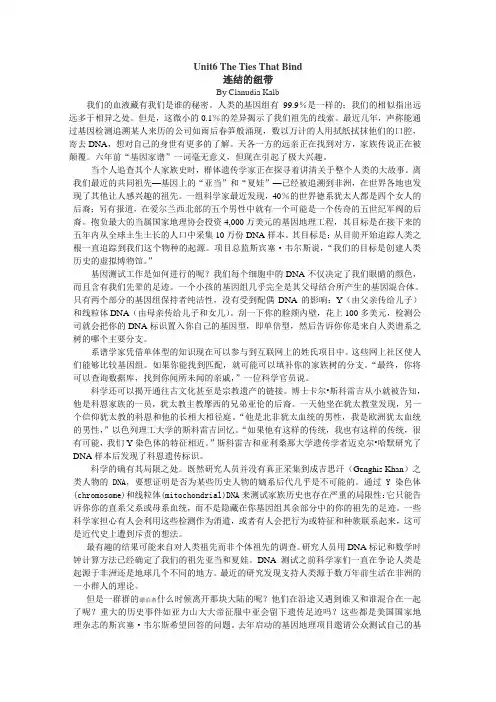
Unit6 The Ties That Bind连结的纽带By Clanudia Kalb我们的血液藏有我们是谁的秘密。
人类的基因组有99.9%是一样的;我们的相似指出远远多于相异之处。
但是,这微小的0.1%的差异揭示了我们祖先的线索。
最近几年,声称能通过基因检测追溯某人来历的公司如雨后春笋般涌现,数以万计的人用拭纸拭抹他们的口腔,寄去DNA,想对自己的身世有更多的了解。
天各一方的远亲正在找到对方,家族传说正在被颠覆。
六年前“基因家谱”一词毫无意义,但现在引起了极大兴趣。
当个人追查其个人家族史时,群体遗传学家正在探寻着讲清关于整个人类的大故事。
离我们最近的共同祖先—基因上的“亚当”和“夏娃”—已经被追溯到非洲,在世界各地也发现了其他让人感兴趣的祖先。
一组科学家最近发现,40%的世界德系犹太人都是四个女人的后裔;另有报道,在爱尔兰西北部的五个男性中就有一个可能是一个传奇的五世纪军阀的后裔。
抱负最大的当属国家地理协会投资4,000万美元的基因地理工程,其目标是在接下来的五年内从全球土生土长的人口中采集10万份DNA样本。
其目标是:从目前开始追踪人类之根一直追踪到我们这个物种的起源。
项目总监斯宾塞·韦尔斯说,“我们的目标是创建人类历史的虚拟博物馆。
”基因测试工作是如何进行的呢?我们每个细胞中的DNA不仅决定了我们眼睛的颜色,而且含有我们先辈的足迹。
一个小孩的基因组几乎完全是其父母结合所产生的基因混合体。
只有两个部分的基因组保持者纯洁性,没有受到配偶DNA的影响:Y(由父亲传给儿子)和线粒体DNA(由母亲传给儿子和女儿)。
刮一下你的脸颊内壁,花上100多美元,检测公司就会把你的DNA标识置入你自己的基因型,即单倍型,然后告诉你你是来自人类谱系之树的哪个主要分支。
系谱学家凭借单体型的知识现在可以参与到互联网上的姓氏项目中。
这些网上社区使人们能够比较基因组。
如果你能找到匹配,就可能可以填补你的家族树的分支。
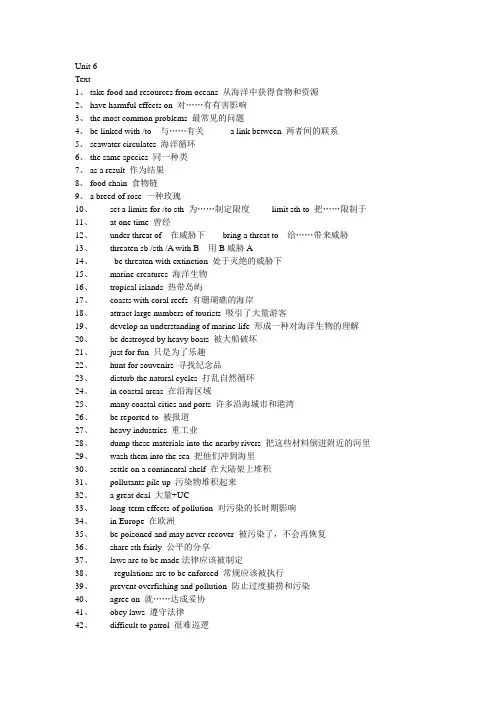
Unit 6Text1、take food and resources from oceans 从海洋中获得食物和资源2、have harmful effects on 对……有有害影响3、the most common problems 最常见的问题4、be linked with /to 与……有关 a link between 两者间的联系5、seawater circulates 海洋循环6、the same species 同一种类7、as a result 作为结果8、food chain 食物链9、a breed of rose 一种玫瑰10、set a limits for /to sth 为……制定限度limit sth to 把……限制于11、at one time 曾经12、under threat of 在威胁下bring a threat to 给……带来威胁13、threaten sb /sth /A with B 用B威胁A14、be threaten with extinction 处于灭绝的威胁下15、marine creatures 海洋生物16、tropical islands 热带岛屿17、coasts with coral reefs 有珊瑚礁的海岸18、attract large numbers of tourists 吸引了大量游客19、develop an understanding of marine life 形成一种对海洋生物的理解20、be destroyed by heavy boats 被大船破坏21、just for fun 只是为了乐趣22、hunt for souvenirs 寻找纪念品23、disturb the natural cycles 打乱自然循环24、in coastal areas 在沿海区域25、many coastal cities and ports 许多沿海城市和港湾26、be reported to 被报道27、heavy industries 重工业28、dump these materials into the nearby rivers 把这些材料倒进附近的河里29、wash them into the sea 把他们冲到海里30、settle on a continental shelf 在大陆架上堆积31、pollutants pile up 污染物堆积起来32、 a great deal 大量+UC33、long-term effects of pollution 对污染的长时期影响34、in Europe 在欧洲35、be poisoned and may never recover 被污染了,不会再恢复36、share sth fairly 公平的分享37、laws are to be made法律应该被制定38、regulations are to be enforced 常规应该被执行39、prevent overfishing and pollution 防止过度捕捞和污染40、agree on 就……达成妥协41、obey laws 遵守法律42、difficult to patrol 很难巡逻43、be generous in 对……慷慨44、 a wide range of resources 大量资源45、pay them back 付回46、the exhaustion of fish 鱼类的耗尽47、lean the lesson 得到教训48、for a variety of purposes 为了很多的目的49、be severely polluted 被严重的破坏50、be aware of 意识到51、be realized that 意识到52、be well managed 被很好的管理V253、take up time /space 占用时间/空间54、break out 爆发55、see that 确保+句子56、care for 照顾care about 担心57、be closely linked with /to 与……有亲密联系58、obtain from trees 从树上得到59、reduce the danger of damaging floods 减少破坏森林的危险60、It is believe that 可以相信+句子61、help control our water supplies 帮助控制我们的水供给62、the illegal cutting down of trees 违法砍伐树木63、be absorb in 被吸收64、vacation spots 假期圣地65、benefit from 从……中获益(V)sth benefit sb ……获益某人66、gain benefits from 从……中获益(N)67、bring endless benefits to sb 给某人带来无尽利益68、practice medicine 从事医学69、mature trees 成熟的树70、be cleared 被清除71、make sure of /that 确保72、rank second 排名第二73、despite the fact that 尽管事实是in spit of =despite 尽管74、simply because 只是因为。
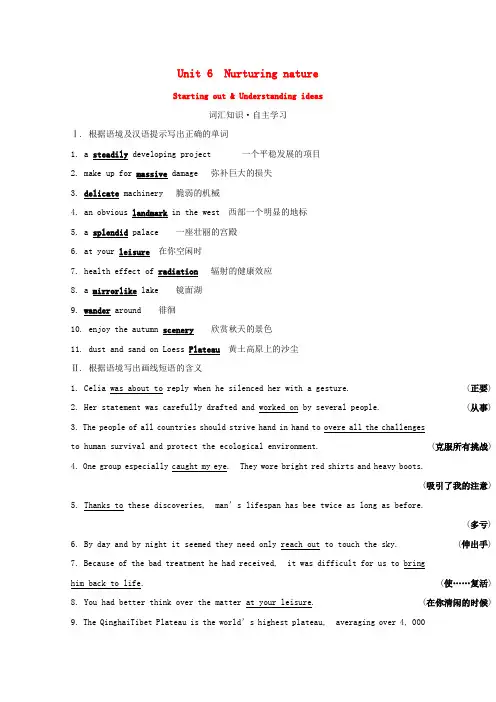
Unit 6 Nurturing natureStarting out & Understanding ideas词汇知识·自主学习Ⅰ. 根据语境及汉语提示写出正确的单词1. a steadily developing project 一个平稳发展的项目2. make up for massive damage 弥补巨大的损失3. delicate machinery 脆弱的机械4. an obvious landmark in the west 西部一个明显的地标5. a splendid palace 一座壮丽的宫殿6. at your leisure在你空闲时7. health effect of radiation辐射的健康效应8. a mirrorlike lake 镜面湖9. wander around 徘徊10. enjoy the autumn scenery欣赏秋天的景色11. dust and sand on Loess Plateau黄土高原上的沙尘Ⅱ. 根据语境写出画线短语的含义1. Celia was about to reply when he silenced her with a gesture. (正要)2. Her statement was carefully drafted and worked on by several people. (从事)3. The people of all countries should strive hand in hand to overe all the challengesto human survival and protect the ecological environment. (克服所有挑战) 4. One group especially caught my eye. They wore bright red shirts and heavy boots.(吸引了我的注意) 5. Thanks to these discoveries, man’s lifespan has bee twice as long as before.(多亏)6. By day and by night it seemed they need only reach out to touch the sky. (伸出手)7. Because of the bad treatment he had received, it was difficult for us to bringhim back to life. (使……复活)8. You had better think over the matter at your leisure. (在你清闲的时候)9. The QinghaiTibet Plateau is the world’s highest plateau, averaging over 4, 000metres above sea level. (海拔) 10. Their factory is located at the foot of the mountain. (位于) Ⅲ. 根据课文及汉语提示补全句子1. How to protect the delicate ecosystem was among the top concerns.如何保护脆弱的生态系统是我们关注的首要问题之一。
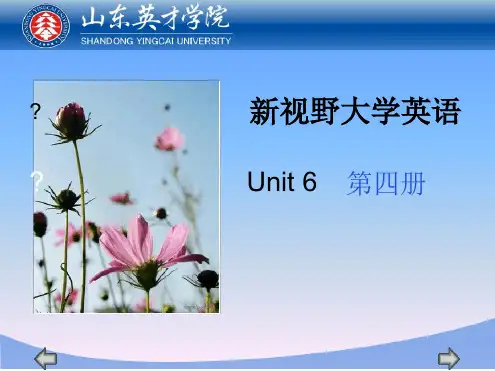
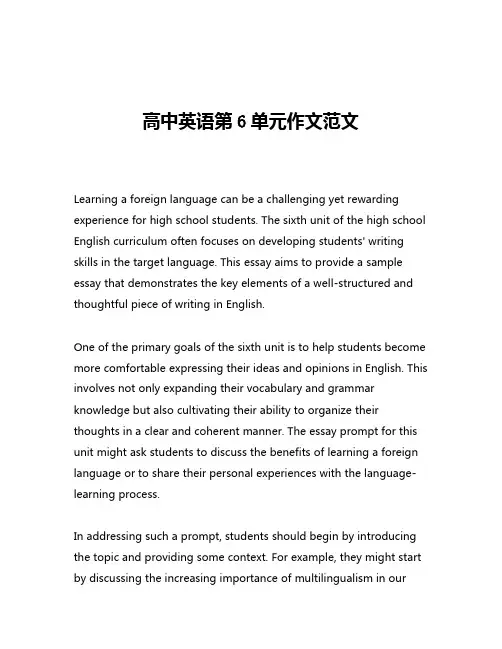
高中英语第6单元作文范文Learning a foreign language can be a challenging yet rewarding experience for high school students. The sixth unit of the high school English curriculum often focuses on developing students' writing skills in the target language. This essay aims to provide a sample essay that demonstrates the key elements of a well-structured and thoughtful piece of writing in English.One of the primary goals of the sixth unit is to help students become more comfortable expressing their ideas and opinions in English. This involves not only expanding their vocabulary and grammar knowledge but also cultivating their ability to organize their thoughts in a clear and coherent manner. The essay prompt for this unit might ask students to discuss the benefits of learning a foreign language or to share their personal experiences with the language-learning process.In addressing such a prompt, students should begin by introducing the topic and providing some context. For example, they might start by discussing the increasing importance of multilingualism in ourglobalized world and how learning a foreign language can open up new opportunities for personal and professional growth. This sets the stage for the main body of the essay, where the writer can delve deeper into the specific advantages of language learning or their own journey with the target language.One key aspect of a strong essay in this unit is the ability to support one's claims with relevant evidence and examples. Students should draw upon their own experiences, observations, or research to substantiate the points they make. This might involve describing specific situations where their language skills have been useful, sharing insights gained from studying the target language's culture and customs, or citing statistics or studies that highlight the cognitive and social benefits of bilingualism.In addition to providing evidence, students should also demonstrate their ability to analyze and synthesize information. Rather than simply listing the pros of language learning, they should explore the underlying reasons and implications of these benefits. For instance, a student might discuss how the discipline and problem-solving skills developed through language study can transfer to other academic and professional contexts.Furthermore, a well-crafted essay in this unit should exhibit a clear organizational structure. The writer should guide the reader throughthe essay's main ideas in a logical and coherent manner, using transitions and topic sentences to create a smooth flow of information. Each paragraph should focus on a specific aspect of the topic, with the introduction and conclusion serving to frame the discussion and reinforce the essay's central message.Throughout the writing process, students should also pay close attention to their language use, striving to demonstrate a strong command of English grammar, vocabulary, and style. This might involve using more advanced sentence structures, incorporating precise and descriptive language, and maintaining a formal, academic tone appropriate for the assignment.By addressing these key elements – a clear introduction and thesis, well-supported body paragraphs, a cohesive organizational structure, and polished language use – students can produce a high-quality essay that showcases their progress in the sixth unit of the high school English curriculum. Such an essay not only meets the expectations of the assignment but also serves as a testament to the student's growing proficiency in the target language.In conclusion, the sample essay presented here provides a model for how high school students can effectively tackle the writing tasks associated with the sixth unit of their English curriculum. By carefully considering the prompt, organizing their ideas, and demonstratingtheir language skills, students can produce a compelling and well-crafted piece of writing that reflects their progress and potential as language learners.。
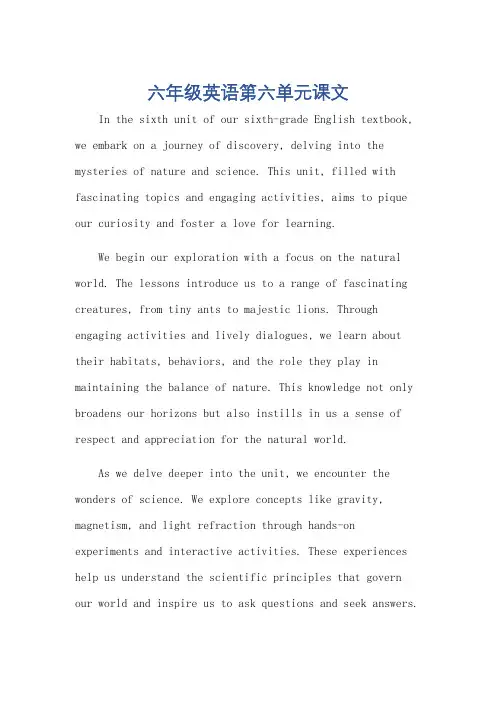
六年级英语第六单元课文In the sixth unit of our sixth-grade English textbook, we embark on a journey of discovery, delving into the mysteries of nature and science. This unit, filled with fascinating topics and engaging activities, aims to pique our curiosity and foster a love for learning.We begin our exploration with a focus on the natural world. The lessons introduce us to a range of fascinating creatures, from tiny ants to majestic lions. Through engaging activities and lively dialogues, we learn about their habitats, behaviors, and the role they play in maintaining the balance of nature. This knowledge not only broadens our horizons but also instills in us a sense of respect and appreciation for the natural world.As we delve deeper into the unit, we encounter the wonders of science. We explore concepts like gravity, magnetism, and light refraction through hands-on experiments and interactive activities. These experiences help us understand the scientific principles that govern our world and inspire us to ask questions and seek answers.The unit also encourages us to think critically and creatively. Through thought-provoking discussions and innovative projects, we are challenged to apply our knowledge and imagination to solve real-world problems.This process not only enhances our cognitive abilities but also cultivates our problem-solving skills and innovative mindset.Moreover, the unit强调团队合作的重要性。
单元素养提升(六) Unit 6Ⅰ. 根据句意或提示填入合适的单词1. He was in a disturbed(disturb) state of mind after learning this, so you’d better not disturb him.2. Our motherland is taking measures to promote the development of Hainan, whose scenery(scene) is beautiful beyond description.3. The last five years have seen a consistent improvement in the country’s economy(economic).4. All the other things are negotiable(negotiate) but the boundary issue.5. When searching for jobs, I am often asked what my highest education qualification(qualify) is?6. What made us annoyed was that they inserted an advertisement(advertise) in the newspaper without permission.7. In addition, wetland soils are known for methane emission(排放), a greenhouse gas.8. She wears a dress with delicate(精美的) lace, which drew much attention from the whole class.9. It is a good message that most candidates(选手) passed in grammar.10. The cathedral is a fantastic modern construction(建筑), which is an attraction to all the tourists.Ⅱ. 完成句子1. Don’t worry, dear, I believe there is one day when you catch another person’s eyes and she will follow you then.别担心, 亲爱的, 我相信有一天你会吸引某个人的目光, 然后她会随你而去。
Section 3Using language—Language Points一、基础词准确填写1.jungle n. 热带丛林2.disturb v. 打扰,扰乱3.economy n. 经济4.operator n. 经营者5.emission n. 散发物,排放物6.conservationist n. 环境保护主义者二、派生词精准变形1.economy n. 经济→economist n. 经济学家→economic adj. 经济的,经济学的2.operator n. 经营者→operation n.手术,行动,企业→operate v. 运转,操作,动手术3.conservationist n. 保护工作者→conserve v.节省;保护,保存4.endanger v. 使遭受危险,危及→endangered adj.濒临灭绝的→danger n. 危险三、重点短语双向记1.for a while 一会儿2.provide sth. for sb. 为某人提供某物3.brush off 掸去,删掉4.in turn 轮流,依次5.in particular 尤其,特别6.be involved in/with sth. 涉及或与某事有牵连7.pull off 扯下8.be_concerned_about 对……担心9.be_in_harmony_with 与……和谐10.reach_an_agreement 达成一致四、重点词汇1.(教材P65)This is an amazing experience and a reminder of how many species there are in the rainforest.这是一个令人惊奇的经历,并提醒我们雨林里有多少物种。
◆reminder n. 起提醒作用的东西remind v.提醒,使想起①—You look sleepy today.—Reminded not to miss the flight, I didn't dare to close my eyes the whole night.——你看起来很困。
I.阅读单词认读01.delicate adj. 脆弱的ndmark n. 地标03.permafrost n. 永久冻土层04.Tibetan adj. 西藏的05.antelope n. 羚羊06.wetland n. 湿地07.grassland n. 草原08.mirror-like adj. 如镜面般的09.plateau n. 高原10.emission n. 散发物, 排放物II.重点单词识记01.splendid adj. 壮丽的02.leisure n. 空闲, 闲暇03.radiation n. 辐射04.wander v. 徘徊; 闲逛05.scenery n. 风景, 景色06.jungle n. (热带)丛林07.candidate n. 申请者08.genuine adj. 真的, 真正的; 真诚的09.salary n. 薪金, 工资10.waist n. 腰, 腰部III.核心词汇拓展01.steadily adv. 平稳地→steady adj. 稳定的02.massive adj. 巨大的→mass n. 块, 团03.economy n. 经济→economic adj. 经济的04.disturb v. 干扰, 扰乱→disturbing adj. 令人不安的→disturbance n. 打扰; 骚乱05.operator n. 经营者; 操作员→operate v. 经营; 操作→operation n. 操作; 经营; 运转; 手术06.conservationist n. (动植物或古旧建筑的)保护工作者; 环境保护主义者→conservation n. 保护→conserve v. 保护; 保存; 节省; 节约07.applicant n. 申请人→apply v. 申请→application n. 申请08.favour n. 支持, 赞同; 帮助→favourable adj. 支持的; 有利的09.advertise v. (为……)做广告(宣传) →advertisement n. 广告→advertising n. 广告活动; 广告业→advertiser n. 广告商10.negotiable adj. 可协商的→negotiate v. 谈判, 协商→negotiation n. 谈判, 协商11.preference n. 优先(权); 偏爱→prefer v. 更喜欢, 偏爱12.qualification n. 资格, 技能条件→qualify v. 使具有资格→qualified adj. 有资格的; 称职的IV.核心短语速记01.at one’s leisure空闲时02.in favour of 支持, 赞同03.overcome the challenges 克服难题04.among the top concerns 高度重视的问题之一05.catch one’s eye吸引某人的注意06.bring... to life使……充满生机07.highlight the importance of 强调……的重要性08.be made up of 由……组成09.under threat from 受到……的威胁10.be located in/at... 位于……11.reach out伸出(手)e up用光13.in particular尤其, 特别14.in harmony with与……协调15.in addition to除了……还有……16.be/become aware of意识到; 知道01.feature n. 特征; 特色02.female adj. 女的; 女性的; 雌性的03.fiction n. 小说; 虚构, 编造04.fierce adj. 猛烈的; 凶猛的05.finance n. 财政; 金融06.financial adj. 财政的; 金融的07.flashlight n. 手电08.flee(fled, fled) vi. 逃走; 逃跑09.flexible adj. 灵活的; 柔韧的; 易弯曲的10.fluency n. 流利11.fluent adj. 流畅的12.fold vt. 折叠; 合拢01.How to protect the delicate ecosystem was among the top concerns. (“疑问词+不定式”作主语)怎样保护脆弱的生态环境是最令人关注的问题。
Unit 6 Immigration: Bound for the United StatesTEACHER: All right. Let’s get started. U.S immigration is our topic today. I know many of you are immigrants, so you know something about this topic. As you may know by my last name, I have a German background; my parents immigrated to the U.S. from Germany about fifty years ago... Y es, question?STUDENT 1: Does that mean you’re an immigrant?TEACHER: Well, no. My parents are immigrants. They came to the States from Germany. I’m a first generation German-American because I was born here. First, we’ll talk briefly about immigration, the history of immigration to the U.S., and the story of diversity in the U.S.To immigrate means to move from one country to another. It’s a permanent move. By contrast, if you go to live and work in France for two years, you don’t immigrate there; you move there temporarily, because you plan to return to your country. So to immigrate means to move to another country to live there indefinitely. Immigration happens all over the world. Most people do it to improve their economic or social situation. What I’ll do now is give you a brief chronology of U.S. immigration. Let’s start with the colonial period, the first wave of immigrants in the seventeenth century. Most immigrants were from Western Europe. Although the Spaniards arrived in 1513, the first permanent settlement in North America was one that the British started in 1607 in Jamestown, Virginia. People were not prohibited from immigrating by the British; anyone could come. Life was difficult, and some people did not survive, but people felt it was worth the risk to have a better life in the colonies. The French, Spanish, and Dutch also came, but in smaller numbers: I should also point out that about 20 percent of the population at this time was African American. However, most weren’t immigrants; they were brought from Africa as slaves. Today we’re limiting our discussion to voluntary immigrants--to people who choose to come to the U.S. Now, by 1775, the U.S. population had grown to about 2.5 million. The country was growing fast. Some thought too fast. So in the 1790s, laws were passed to control immigration for the first time. The Naturalization Act of 1798 required immigrants to live in the U.S, a certain number of years before they became citizens.The second big wave of immigration happened between 1840 and 1920. During this wave, about 37 million people came to the U.S. The industrial revolution had begun in Europe, causing a big shift from farming to factory jobs. Many left for the U.S., hoping to continue doing the farming jobs they knew. About 80 percent of these second wave immigrants were from all over Europe. During this second wave, Chinese workers also came to the U.S., mostly as contract workers. They arranged, or contracted, to work for an American company before they left home. Most of them worked in the gold mines of California, and later built railroads. Then laws were passed in the 1880s to keep most contract workers out.Now let’s see, where are we? Ah, yes, uh, 1891. In 1891, the U.S. Congress created the INS, the Immigration and Naturalization Service, to control immigration. Any of you who want to immigrate to the U.S. have heard of the INS. Up until 1891, each state had its own laws and could decide which immigrants could enter. So no one really controlled the total number of people allowed in each year. After 1891, the federal government made the laws instead. A year later, in 1892, the INS opened Ellis Island, in New Y ork Harbor. Ships would go past the Statue of Liberty, the symbol of a new life for many people, and stop at Ellis Island. Have any of you seen EllisIsland? Or the Statue of Liberty? Y ou have, Stefan?STUDENT 2: Y es, I have. The Statue of Liberty and Ellis Island.TEACHER: What did you think?STUDENT 2: V ery impressive. Interesting, too.TEACHER: Y es, it is interesting now that Ellis Island has been made into a museum. It’s an important part of American history. Between 1892 and 1954, when Ellis Island was closed, about 12 million immigrants entered through there, most from Europe. I’d encourage you all to go for a visit.Let’s go back for a minute. About 9 million people entered the U.S. between 1900 and 1910. As a result, the U.S. government decided that it needed to limit the number of immigrants. This led to a series of new laws. First, the Immigration Act of 1917 was passed to restrict who could enter. Then in 1921, the U.S. Congress passed a quota system. This meant they decided that a certain number of people from each country could enter the U.S. each year. For example, 2 million from Germany could enter. Once that number had immigrated, no more were allowed until the next yeah. That’s how the quota system worked. During this period, say up until the 1960s, the U.S. was called a “melting pot.” The attitude was that immigrants had to give up their traditions and cultures in order to create a uniform society. People were expected to forget about being Italian or Chinese. They were expected to learn English and to adjust to American ways of doing things. Now, let’s look at the third wave,-the period from 1965 to the present time. In 1965, the quota system was abolished. Instead, a limit of 290,000 was set on the total number of people who could enter each year. During the 1970s and 1980s, about 80 percent of the immigrants were from Latin America and Asia, and only 20 percent were from Europe and elsewhere. So if you compare the second and third waves, you see that in the second wave it was mostly Europeans, and in the third wave it was mostly Latin Americans and Asians. Again, economic opportunity was the main reason people immigrated. Each year, after 1965, many people wanted to immigrate to the U.S., many more than the 290,000 limit. This led to the Immigration Act of 1990. The Immigration Act of 1990 raised the yearly limit from 290,000 to 700,000. However, from 1990 to the present, the actual number has been closer to 1 million, one reason for this being that the U.S. needs workers for many of its service jobs, such as in restaurants or hotels or in farming.In recent years, many people in the U.S. have come to realize that the country’s greatest strength is the diversity of its people. So, the old melting pot ideal has been replaced with the ideal of cultural diversity, with recognizing the importance of Americans’many different cultural backgrounds. Y ou can see this today in strong communities that are Korean-American, Japanese-American, Italian-American, Mexican-American, and so on. Any questions about this? Susan?STUDENT 3: I’m confused. I thought the melting pot was a good thing, that people should mix together and form a strong society.TEACHER: Yes, I think you’re right--we do want to mix together and form a strong society. But now the metaphor is that we want to have a mixed salad, where each ingredient keeps its original flavor, too. Does that sound like a good thing?STUDENT 3: Y es, it makes sense.TEACHER: Welt, let’s sum up. There were several waves of immigration into the U.S. The earlier waves were mostly Europeans, while the later waves have been mostly people from Latin America and Asia. The main reason has always been economic; they are looking for better jobs and a better life than they had in their home country. In the next class, I’m going to talk about currentimmigration laws. We’ll start there next time. That’s all for today.。
word
赴美国旅游签证知识
要获得赴美旅游签证,申请人必须证明其短期单独进入美国的目的仅为旅游,有合理的旅游目的,有足够经济能力支付申请人旅游和在美国期间所需费用;在国外有不可放弃的居住权;短暂停留后必须回国的不可分割的社会、经济和其他关系。
根据1952年的移民与国籍法的修正案条款中第214(6)段,如果申请人不能向领事馆官员提交上述材料的,消除移民倾向,领事官员将不会为其颁发签证。
这种签证颁发给赴美国旅游的申请人,包括探亲访友以及参加非专业性的会议。
该签证持有者不得在美国停留期间就业。
该签证为3个月1次有效,这种签证没有签证费。
1 / 1。
Unit 6 Immigration: Bound for the United StatesTEACHER: All right. Let’s get started. U.S immigration is our topic today. I know many of you are immigrants, so you know something about this topic. As you may know by my last name, I have a German background; my parents immigrated to the U.S. from Germany about fifty years ago... Y es, question?STUDENT 1: Does that mean you’re an immigrant?TEACHER: Well, no. My parents are immigrants. They came to the States from Germany. I’m a first generation German-American because I was born here. First, we’ll talk briefly about immigration, the history of immigration to the U.S., and the story of diversity in the U.S.To immigrate means to move from one country to another. It’s a permanent move. By contrast, if you go to live and work in France for two years, you don’t immigrate there; you move there temporarily, because you plan to return to your country. So to immigrate means to move to another country to live there indefinitely. Immigration happens all over the world. Most people do it to improve their economic or social situation. What I’ll do now is give you a brief chronology of U.S. immigration. Let’s start with the colonial period, the first wave of immigrants in the seventeenth century. Most immigrants were from Western Europe. Although the Spaniards arrived in 1513, the first permanent settlement in North America was one that the British started in 1607 in Jamestown, Virginia. People were not prohibited from immigrating by the British; anyone could come. Life was difficult, and some people did not survive, but people felt it was worth the risk to have a better life in the colonies. The French, Spanish, and Dutch also came, but in smaller numbers: I should also point out that about 20 percent of the population at this time was African American. However, most weren’t immigrants; they were brought from Africa as slaves. Today we’re limiting our discussion to voluntary immigrants--to people who choose to come to the U.S. Now, by 1775, the U.S. population had grown to about 2.5 million. The country was growing fast. Some thought too fast. So in the 1790s, laws were passed to control immigration for the first time. The Naturalization Act of 1798 required immigrants to live in the U.S, a certain number of years before they became citizens.The second big wave of immigration happened between 1840 and 1920. During this wave, about 37 million people came to the U.S. The industrial revolution had begun in Europe, causing a big shift from farming to factory jobs. Many left for the U.S., hoping to continue doing the farming jobs they knew. About 80 percent of these second wave immigrants were from all over Europe. During this second wave, Chinese workers also came to the U.S., mostly as contract workers. They arranged, or contracted, to work for an American company before they left home. Most of them worked in the gold mines of California, and later built railroads. Then laws were passed in the 1880s to keep most contract workers out.Now let’s see, where are we? Ah, yes, uh, 1891. In 1891, the U.S. Congress created the INS, the Immigration and Naturalization Service, to control immigration. Any of you who want to immigrate to the U.S. have heard of the INS. Up until 1891, each state had its own laws and could decide which immigrants could enter. So no one really controlled the total number of people allowed in each year. After 1891, the federal government made the laws instead. A year later, in 1892, the INS opened Ellis Island, in New Y ork Harbor. Ships would go past the Statue of Liberty, the symbol of a new life for many people, and stop at Ellis Island. Have any of you seen EllisIsland? Or the Statue of Liberty? Y ou have, Stefan?STUDENT 2: Y es, I have. The Statue of Liberty and Ellis Island.TEACHER: What did you think?STUDENT 2: V ery impressive. Interesting, too.TEACHER: Y es, it is interesting now that Ellis Island has been made into a museum. It’s an important part of American history. Between 1892 and 1954, when Ellis Island was closed, about 12 million immigrants entered through there, most from Europe. I’d encourage you all to go for a visit.Let’s go back for a minute. About 9 million people entered the U.S. between 1900 and 1910. As a result, the U.S. government decided that it needed to limit the number of immigrants. This led to a series of new laws. First, the Immigration Act of 1917 was passed to restrict who could enter. Then in 1921, the U.S. Congress passed a quota system. This meant they decided that a certain number of people from each country could enter the U.S. each year. For example, 2 million from Germany could enter. Once that number had immigrated, no more were allowed until the next yeah. That’s how the quota system worked. During this period, say up until the 1960s, the U.S. was called a “melting pot.” The attitude was that immigrants had to give up their traditions and cultures in order to create a uniform society. People were expected to forget about being Italian or Chinese. They were expected to learn English and to adjust to American ways of doing things. Now, let’s look at the third wave,-the period from 1965 to the present time. In 1965, the quota system was abolished. Instead, a limit of 290,000 was set on the total number of people who could enter each year. During the 1970s and 1980s, about 80 percent of the immigrants were from Latin America and Asia, and only 20 percent were from Europe and elsewhere. So if you compare the second and third waves, you see that in the second wave it was mostly Europeans, and in the third wave it was mostly Latin Americans and Asians. Again, economic opportunity was the main reason people immigrated. Each year, after 1965, many people wanted to immigrate to the U.S., many more than the 290,000 limit. This led to the Immigration Act of 1990. The Immigration Act of 1990 raised the yearly limit from 290,000 to 700,000. However, from 1990 to the present, the actual number has been closer to 1 million, one reason for this being that the U.S. needs workers for many of its service jobs, such as in restaurants or hotels or in farming.In recent years, many people in the U.S. have come to realize that the country’s greatest strength is the diversity of its people. So, the old melting pot ideal has been replaced with the ideal of cultural diversity, with recognizing the importance of Americans’many different cultural backgrounds. Y ou can see this today in strong communities that are Korean-American, Japanese-American, Italian-American, Mexican-American, and so on. Any questions about this? Susan?STUDENT 3: I’m confused. I thought the melting pot was a good thing, that people should mix together and form a strong society.TEACHER: Yes, I think you’re right--we do want to mix together and form a strong society. But now the metaphor is that we want to have a mixed salad, where each ingredient keeps its original flavor, too. Does that sound like a good thing?STUDENT 3: Y es, it makes sense.TEACHER: Welt, let’s sum up. There were several waves of immigration into the U.S. The earlier waves were mostly Europeans, while the later waves have been mostly people from Latin America and Asia. The main reason has always been economic; they are looking for better jobs and a better life than they had in their home country. In the next class, I’m going to talk about currentimmigration laws. We’ll start there next time. That’s all for today.。